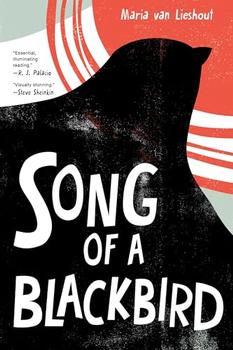Summary | Excerpt | Reviews | Beyond the Book | Read-Alikes | Genres & Themes | Author Bio

This article relates to Song of a Blackbird
 Song of a Blackbird is a dual timeline narrative that follows the lives of two young women, one in modern day and one during WWII. In 2011, Annick goes on a search to find her family's true history, her only clues a set of prints featuring buildings around Amsterdam signed by a mysterious "Emma B." And in Nazi-occupied Amsterdam, the artist, Emma Bergsma, works against the Nazis by using her art skills to create forged documents. Maria van Lieshout's debut graphic novel features simple illustrations superimposed over historical photographs taken by people who were resisting the Nazis in a different way.
Song of a Blackbird is a dual timeline narrative that follows the lives of two young women, one in modern day and one during WWII. In 2011, Annick goes on a search to find her family's true history, her only clues a set of prints featuring buildings around Amsterdam signed by a mysterious "Emma B." And in Nazi-occupied Amsterdam, the artist, Emma Bergsma, works against the Nazis by using her art skills to create forged documents. Maria van Lieshout's debut graphic novel features simple illustrations superimposed over historical photographs taken by people who were resisting the Nazis in a different way.
For most of the war, it wasn't necessarily illegal to take photographs, but a camera could still lead to accusations of sabotage or deception and result in arrest. Despite this, plenty risked their lives to capture images of the suffering of Amsterdam's people. Then, in November 1944, Hans Albin Rauter, the SS General and Police Chief of the city, declared it "forbidden to take photographs, to make films or drawings, as well as to depict in whatever way persons and objects located outside the private domain," making photography for any reason incredibly dangerous.
Prior to the ban, two resistance fighters—Fritz Kahlenberg, a German-Jewish filmmaker, and Tony van Renterghem, chief of staff of the Internal Armed Forces in Amsterdam South—approached photographers throughout the city with a mission: to take photographs of the occupation to help document the effects of war, to identify war criminals and collaborators, and to be used as evidence after liberation. During the war, these resistance photographers operated as Nederland Archief ("Netherlands Archives"), but after, they earned the moniker De Ondergedoken Camera ("Hidden Camera" or "Underground Camera"). People of different genders and ages, some of whom became well-known after the war, used whatever cameras they could find to do their work. Women were often more successful at getting photographs, as they could more easily hide their cameras in props such as handbags, muffs, or baby carriages. While the work was dangerous for everyone involved, it proved invaluable: photographs taken during the famine that beset Amsterdam during the winter of 1944 and 1945 served as necessary evidence for the Dutch government in exile to successfully request food drops to the western provinces of the Netherlands. Similarly, photographs of malnourished children, looted or destroyed homes, and people openly flouting Nazi laws gave foreigners accurate depictions of survival and resistance in the city.
De Ondergedoken Camera produced thousands of photographs during the war, many of which have been displayed in collections or special exhibits at museums and universities, including the NIOD Institute for War, Holocaust, and Genocide Studies; the Nederlands Fotomuseum; and Foam, an international photography museum based in Amsterdam. Despite all the works from these photographers, there remain many questions about the day-to-day aspects of the group, such as the identities of many of the subjects in the photographs, how the group was organized, and how the leadership operated.
At the end of her book, van Lieshout notes that many of the photographs featured in Annick's and Emma's stories were taken by members of De Ondergedoken Camera. While most of the photos are exterior scenes showing locations mentioned in the story, some are interior shots, and some are specifically of people: actors on stage at the Dutch Theater; a class of students at the Reformed Teacher Training College; a group of Jewish children separated from their parents prior to deportation; resistance members working at a printing press; the liberation parade in April 1945. The use of these historical photographs in Song of a Blackbird reminds readers that although Annick's and Emma's stories are fictionalized, they are based on true stories and events. More importantly, they bring to light the stories of brave people who fought back against a regime of hate and destruction through art.
Image courtesy of NIOD Institute for War, Holocaust and Genocide Studies.
Filed under People, Eras & Events
![]() This article relates to Song of a Blackbird.
It first ran in the February 12, 2025
issue of BookBrowse Recommends.
This article relates to Song of a Blackbird.
It first ran in the February 12, 2025
issue of BookBrowse Recommends.
Your guide toexceptional books
BookBrowse seeks out and recommends the best in contemporary fiction and nonfiction—books that not only engage and entertain but also deepen our understanding of ourselves and the world around us.